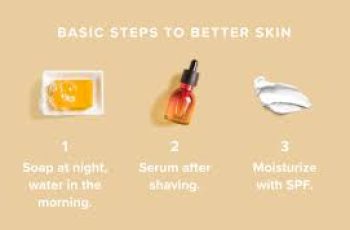
Can I Use Glycolic Acid and Mandelic Acid Together? A Complete Guide
If you’re exploring chemical exfoliants, it’s easy to feel like a skincare mad scientist. Mixing and matching acids can be confusing, especially when each one promises unique benefits.
Without a clear understanding, you might misuse them or cause irritation. Even if products say they are mild, they’re still acids that require careful handling and sun protection.
So, can you use glycolic acid and mandelic acid together? Let’s find out.
What Are Chemical Exfoliants?
Chemical exfoliants are acids that help remove dead skin cells from the surface of your skin. Unlike physical exfoliants, they dissolve the bonds holding dead skin cells together without scrubbing. This makes them effective, gentle, and suitable for many skin types when used correctly.
Two popular types of chemical exfoliants are alpha hydroxy acids (AHAs) and beta hydroxy acids (BHAs). AHAs, like glycolic and mandelic acid, are water-soluble and work mainly on the skin’s surface. BHAs, like salicylic acid, penetrate deeper into pores and are oil-soluble.
What Is Glycolic Acid?
Glycolic acid is a well-known AHA derived from sugar cane. It’s one of the most popular acids in skincare and found in many toners, serums, and moisturizers.
Glycolic acid has the smallest molecular size among AHAs.
Its small molecules allow it to penetrate deeply into the skin.
It works inside pores to clear excess sebum, dirt, bacteria, and impurities.
By exfoliating dead skin cells, it helps prevent blackheads, acne, and blemishes.
It also smooths fine lines and wrinkles, promoting a youthful, plump complexion.
Because glycolic acid removes dead skin cells, it increases skin absorption of other actives.
However, glycolic acid can be irritating for sensitive skin due to its deep penetration.
It’s generally best for skin types that are not overly dry or sensitive.
Once your skin builds tolerance, you can use glycolic acid up to twice daily.
It works well alone or combined with hydrating ingredients like hyaluronic acid.
What Is Mandelic Acid?
Mandelic acid is another AHA but less commonly discussed. It’s derived from bitter almonds and is used in both medical peels and over-the-counter skincare.
Mandelic acid molecules are larger than glycolic acid’s.
This means it penetrates more slowly and gently into the skin.
It’s considered one of the mildest AHAs, suitable for all skin types.
Mandelic acid exfoliates the skin’s surface, improving texture and tone.
It unclogs pores and reduces breakouts without irritation.
It’s especially effective at fading dark spots, hyperpigmentation, and acne scars.
Like glycolic acid, it helps your skin absorb other ingredients better.
Though gentle, it’s best to introduce mandelic acid gradually to avoid irritation.
Benefits of Glycolic Acid and Mandelic Acid
Both acids offer exfoliation and skin-renewal benefits, but they suit different needs:
Glycolic acid penetrates deeper, making it ideal for aging skin, uneven texture, and stubborn breakouts.
Mandelic acid works on the surface, great for sensitive skin and discoloration.
Both improve skin radiance, smoothness, and clarity.
They boost collagen production, helping to reduce fine lines.
Both can be layered with hydrating ingredients to keep skin balanced.
Can You Use Glycolic Acid and Mandelic Acid Together?
The short answer: yes, but not simultaneously.
Using both acids at the same time can overstimulate your skin, leading to:
Redness, Itching, Dryness, Flaking, Swelling
Increased sensitivity to sunlight
These effects result from over-exfoliation and can damage your skin barrier.
How to Use Both Acids Safely
Option 1: Alternate Days
Use glycolic acid one day, mandelic acid the next. This prevents irritation and allows your skin to recover between treatments. Many people prefer applying acids at night to avoid daytime UV exposure.
Option 2: Morning and Evening Split
Once your skin builds tolerance, you can use one acid in the morning and the other in the evening. Always follow with a broad-spectrum sunscreen of SPF 50 or higher to protect against UV damage.
Supporting Your Skin Barrier
When using exfoliating acids, hydration and protection are essential:
Use ingredients like hyaluronic acid to keep skin moisturized.
Niacinamide supports the skin barrier and reduces inflammation.
Avoid combining acids with harsh ingredients like retinoids or vitamin C initially.
Always apply sunscreen daily; acids make skin more prone to sun damage.
If irritation occurs, reduce frequency or pause acid use.
Is Mandelic Acid Stronger Than Glycolic Acid?
Technically, glycolic acid is stronger due to its smaller molecule size and deeper skin penetration.
Glycolic acid works deeper into the dermis.
Mandelic acid mainly affects the skin surface.
Mandelic acid is more gentle and better tolerated by sensitive skin.
The concentration of acid in a product also affects strength.
Look at ingredient lists: if an acid is near the top, it means a higher concentration.
A lower percentage of glycolic acid may be milder than a higher percentage of mandelic acid.
When to Avoid Using Glycolic or Mandelic Acid
Certain skin conditions or circumstances mean you should be cautious or avoid these acids:
Active eczema or dermatitis
Open wounds or sunburn
Very sensitive or reactive skin
During pregnancy, consult your healthcare provider
If you’re using strong prescription medications (retinoids, antibiotics)
Always do a patch test before adding new acids to your routine.
Signs Your Skin Loves These Acids
When used correctly, glycolic and mandelic acid can transform your skin:
Smoother texture and softer skin
Reduced breakouts and clearer pores
Brighter, more even skin tone
Fading dark spots and scars
Minimized fine lines and wrinkles
Better absorption of other skincare products
Frequently Asked Questions (FAQs)
Q: Can I mix glycolic acid and mandelic acid in the same product?
A: Usually no. Most products use one acid to avoid irritation. Layering two acids is not recommended without expert guidance.
Q: How long does it take to see results?
A: Typically, 4-6 weeks of consistent use show visible improvements.
Q: Can I use acids daily?
A: Start slowly, 2-3 times a week. Increase frequency as your skin builds tolerance.
Q: What should I do if I experience irritation?
A: Stop using the acids, moisturize, and consult a dermatologist if irritation persists.
Final Words
Glycolic acid and mandelic acid are powerful exfoliants that can elevate your skincare routine. Using them together is possible, but only with care.
Alternate their use or separate them by AM and PM routines to avoid irritation.
Support your skin barrier with hydrating and soothing ingredients and always protect yourself from the sun. With patience and consistency, these acids can give you smoother, brighter, and healthier skin.
If you want more personalized advice, reach out to us on Instagram or your trusted skincare professional. Happy exfoliating!


